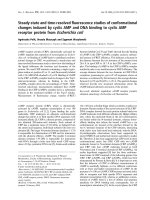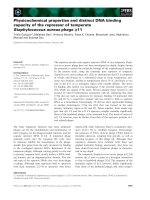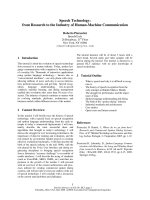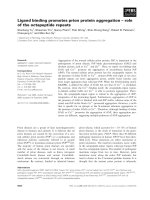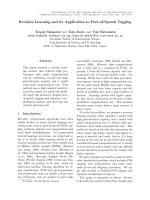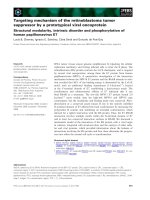Báo cáo khoa học: "Targeting alphavbeta3 and alphavbeta5 inhibits photon-induced hypermigration of malignant glioma cells" pot
Bạn đang xem bản rút gọn của tài liệu. Xem và tải ngay bản đầy đủ của tài liệu tại đây (779.07 KB, 32 trang )
Radiation Oncology
This Provisional PDF corresponds to the article as it appeared upon acceptance. Fully formatted
PDF and full text (HTML) versions will be made available soon.
Targeting alphavbeta3 and alphavbeta5 inhibits photon-induced hypermigration
of malignant glioma cells
Radiation Oncology 2011, 6:132
doi:10.1186/1748-717X-6-132
Stefan Rieken ()
Daniel Habermehl ()
Angela Mohr ()
Lena Wuerth ()
Katja Lindel ()
Klaus Weber ()
Jurgen Debus ()
Stephanie E Combs ()
ISSN
Article type
1748-717X
Research
Submission date
31 May 2011
Acceptance date
6 October 2011
Publication date
6 October 2011
Article URL
/>
This peer-reviewed article was published immediately upon acceptance. It can be downloaded,
printed and distributed freely for any purposes (see copyright notice below).
Articles in Radiation Oncology are listed in PubMed and archived at PubMed Central.
For information about publishing your research in Radiation Oncology or any BioMed Central journal,
go to
/>For information about other BioMed Central publications go to
/>© 2011 Rieken et al. ; licensee BioMed Central Ltd.
This is an open access article distributed under the terms of the Creative Commons Attribution License ( />which permits unrestricted use, distribution, and reproduction in any medium, provided the original work is properly cited.
Targeting ανβ3 and ανβ5 inhibits photoninduced hypermigration of malignant
glioma cells
Stefan Rieken, Daniel Habermehl, Angela Mohr, Lena Wuerth, Katja Lindel, Klaus
Weber, Jürgen Debus, and Stephanie E. Combs
University Hospital of Heidelberg, Department of Radiation Oncology, Im
Neuenheimer Feld 400, 69120 Heidelberg, Germany
E-mail addresses:
SR:
DH:
AM:
LW:
LK:
KW:
JD:
SC:
Corresponding Author:
Stefan Rieken MD
Neuro-Radiation Oncology Research Group
University of Heidelberg
Department of Radiation Oncology
Im Neuenheimer Feld 400
69120 Heidelberg
Germany
Phone: 49-6221-56-8202
Fax: 49-6221-56-5353
e-mail:
Abstract:
Background:
Sublethal photon irradiation was recently suspected to increase tumor cell motility
and promote locoregional recurrence of disease. This study was set up to describe
mechanisms underlying increased glioma cell migration through photon irradiation
and to analyse the modifiability of photon-altered glioma cell motility by integrin
inhibition.
Methods:
Eight µm pore size membranes were coated with vitronectin (VN), collagen I and
collagen IV. U87 and Ln229 glioma cells were analysed in migration experiments with
and without radiotherapy (RT), serum stimulation and addition of monoclonal
antibodies directed to human integrins ανβ3 and ανβ5. Quantitative FACS analysis of
integrins was performed in U87 and Ln229 glioma cells following RT. Statistical
analysis was performed using Student’s t-test.
Results:
Glioma cell migration is serum-dependent and can be increased by photon RT which
leads to enhanced expression of Vn receptor integrins. Blocking of either ανβ3 or ανβ5
integrins by antibodies inhibits Vn-based migration of both untreated and photonirradiated glioma cells.
Conclusions:
Peripheral glioma cells are at risk of attraction into the adjacent healthy brain by
serum components leaking through the blood brain barrier (BBB). Radiation therapy
is associated with upregulation of Vn receptor integrins and enhanced glioma cell
migration at sublethal doses. This effect can be inhibited by specific integrin
blockade. Future therapeutical benefit may be derived from pharmacological integrin
inhibition in combination with photon irradiation.
Key words:
glioma, radiotherapy, migration, integrin, vitronectin
Introduction:
Despite continuously evolving therapy regimes including extensive neurosurgery,
multiagent chemotherapy, and dose-escalated conformal radiotherapy, primary brain
tumors have not ceased to account for high lethality after short periods of time in
most patients. Deep locoregional tumor cell infiltration that eludes modern imaging
techniques and hampers complete local resection was accounted responsible for
early relapse and spread of disease throughout the brain. Current glioma therapy
involves surgical tumor resection followed by adjuvant radiotherapy combined with
concomitant and adjuvant chemotherapy [1].
As opposed to the tissue they originate from, most tumor cells, including malignant
glioma cells, possess the unique ability to migrate and adhere to various surfaces,
displaying polyligand-induced motile phenotypes where non-malignant cells are
subjected to strictly regulated tissue architecture. Deregulated tumor cell migration is
typically associated with infiltration and dissemination, resulting in local disease
progression and metastases, both of which account for the majority of cancerassociated deaths. In gliomas abundant promigratory mediators have been identified
including lipids and peptides, all of which can be detected in serum reaching the
brain via the tumor-disrupted BBB [2-6].
Besides factors of the microenvironment surrounding the tumor, also its treatment
may effect the migratory behavior of tumor cells. Radiation therapy, which is
implemented in virtually all concepts of glioma treatment, was recently observed to
increase tumor cell motility in vitro at sublethal doses < 3 Gray (Gy) [7, 8]. Increasing
cellular movement in malignant gliomas would undermine the therapeutical intent and
possibly impose a greater risk of deep locoregional tumor infiltration and
metastasization in vivo onto the patients than even without therapy. Furthermore,
photon irradiation is kown to modulate the expression of extracellular matrix proteins
and thus alter the motility-determining environment of malignant gliomas [9].
Depending on their tissue of origin, tumor cells employ a variety of ECM proteins to
adhere to and migrate on. Primary brain tumors are known to produce and contain
abundant amounts of collagens and other ECM components that promote increased
motility, induce invasion and clinically account for poor local control [10, 11].
Molecular therapies have long been introduced into the treatment of malignant
gliomas and have defined epithelial and vascular growth factor but also integrin
receptors as promising targets [12-14]. Integrin signalling is known to significantly
impact glioma cell motility but also survival, and has therefore emerged as a
promising approach to targeted glioma treatment [15]. To date, only little data exists
addressing the impact that a combination of photon irradiation and integrin-inhibition
may have on glioma cell migration. This study was set up in order to characterize
ECM-based motility of U87 and Ln229 glioma cells after photon irradiation and to
analyse the impact of inhibition of Vn receptor integrins in combination with
radiotherapy.
Materials and Methods:
Cell culture
U87-MG glioma cells were purchased from LGC Promochem (ATTC HTB-14), and
kept at 37 ° and 5 % CO2 in DMEM (FG0415 Biochrom AG) supplemented with 1 %
C
Penicilline/Streptomycine and 10 % FCS. Ln229 glioma cells were purchased from
LGC Promochem (ATTC CRL-2611), and kept at 37 ° and 5 % CO2 in DMEM
C
(FG0415 Biochrom AG) supplemented with 1 % Penicillin/Streptomycin and 10 %
FCS. Twenty-four hours before adhesion and migration experiments, cells were
serum starved in DMEM containing 1 % Penicilline/Streptomycine and 0.5 % FCS.
Passaging of cells was performed every week.
Surface coating with extracellular matrix proteins
For migration assays, polycarbonate membranes with 8 µm pores were coated with
50 ng/cm2 vitronectin, 0.5 µg/cm2 collagen I and 0.5 µg/cm2 collagen IV over night at
4 ° and washed in twice destillated and salt-free water prior to the experiments.
C
Migration assay
Five x 103 cells were loaded in the upper chamber of a 48-well modified
microchemotaxis chamber (Multiwell Chemotaxis Chamber, Neuro Probe).
The
lower well contained cell culture medium with 0.5 % FCS and chemoattractants as
indicated.
Lower and upper chambers were separated by a 8 µm pore size
polycarbonate membrane, that had been coated with vitronectin (50ng/cm2), collagen
I (0.5 µg/cm2) and collagen IV (0.5 µg/cm2) 24 hours before the start of migration.
Cells were serum-starved in medium containing 0.5 % FCS 24 hours prior to the start
of migration. Radiation treatments were performed 24 hours before assessment of
migration. Before staining and mounting of Boyden chamber membranes, nonmigrated cells on the upper filter side were removed by drawing the filter over a wiper
blade at least twice. Cytoseal XYL mounting medium was used for filter preservation
(Richard-Allan Scientific). Transmigrated cells were stained with DiffQuick® and
counted with a Leica DC300F microscope. Integrin blockade was performed using
monoclonal antibodies directed against ανβ3- (MAB3050, R&D) and ανβ5-integrins
(MAB 2528, R&D). All assays were done in at least triplicates and wells were
counted by an investigator blinded to experimental set-up. Cell numbers are
expressed as multiples of controls or as proportion of inputs.
FACS analysis
Twenty-four hours after irradiation, cells were fixed with 70% ethanol and stained with
a PE-labelled anibody directed against ανβ3 (555505, BD) and a FITC-labelled
antibody directed against ανβ5 (FAB2528P, R&D). Ln229 and U87 glioma cells were
analysed with a three-colour FACScan flow cytometer and CellQuestPro software
(BD Biosciences). Results are displayed with histogram plots and subsequent
quantitative analyses.
Radiation treatment
Photon radiation was performed using with a 6 MeV linear accelerator (Siemens,
Erlangen, Germany). We applied single doses of 2, 5, and 10 Gy 24 hours prior to
migration experiments.
Statistics
All migration experiments and FACS analyses were performed at least three times.
Modified Boyden Chamber assays were set up in triplicates and analysed by an
investigator blinded to experimental setup. Data are displayed as means ± standard
deviation (SD). Comparisons between two groups were performed with Student’s ttest.
Results:
Glioma cell migration is promoted by serum exposition
Modified Boyden chamber assays were performed to analyse transmigration of U87
glioma cells through 8 µm pore size polycarbonate membranes coated with Vn and
collagen I and IV. In order to mimic a disturbed BBB with leakage of blood-borne
mediators, such as often detected in brain tumors, cells were attracted by serum.
This gradient clearly increased the number of transmigrated glioma cells (Fig. 1).
Compared to unstimulated conditions, serum exposition using a 10% FCS gradient
increased chemotactic transmigration by a factor of 2.91 (p<0.0001), 2.90 (p=0.0004)
and 2.89 (p<0.0001) through Vn-, collagen I- and collagen IV-coated filters (Fig. 1).
Sublethal photon irradiation enhances glioma cell migration
Since photon irradiation is implemented in most glioma treatment protocols, we
irradiated U87 glioma cells with single photon doses of 2 Gy and analysed
transmigration 24 hours afterwards. Single photon doses of 2 Gy promoted glioma
cell transmigration (Fig. 2). On collagen I-coated surfaces, the fraction of
transmigrated cells was increased from 15.3% to 22.9% (p=0.0002); on collagen IV
transmigration was raised from 11.6% to 20.1% (p=0.01). The highest photon
stimulation of migration was detected on Vn-coated membranes, where an increase
from 11.1% to 32.3.% was observed (p<0.0001).
Photon irradiation increases expression of vitronectin receptor integrins ανβ3
and ανβ5
Quantitative FACS analyses using PE- and FITC-labelled antibodies directed against
the Vn receptor integrins ανβ3 and ανβ5 on cell surfaces were performed in order to
investigate the effects of photon RT on integrin expression. We found that single
doses of 2 and 10 Gy caused a rightshift in the FACS histograms (Fig. 3A) and
increased the expression of both ανβ3 and ανβ5 24 hours after irradiation (Fig. 3B).
This rightshift was consistent for all doses tested and for both ανβ3 and ανβ5 in U87
cells. However, statistical significance was only reached for expression of ανβ5 after
10 Gy (p<0.05).
To confirm that this phenomenon was not limited to U87 glioma cells (Fig. 3B, upper
row), we analysed Ln229 glioma cells and found the same phenotype of enhanced
integrin expression following photon RT (Fig. 3B, lower row). Photon-induced
upregulation of integrins was particularly strong for ανβ5 in Ln229 cells, where
statistical significance was reached for all photon doses tested (p<0.05).
Inhibition of ανβ3 and ανβ5 significantly impairs photon-induced hypermigration
In order to analyse the effect of the integrin-disruption, we used Vn receptor-targeting
anti-ανβ3- and -ανβ5-antibodies in Vn-based migration experiments and found that
concentrations of 50 ng/ml impaired glioma cell migration. Both single inhibition of
either ανβ3 and ανβ5 caused significantly reduced transmigration in both U87 (Fig. 4)
and Ln229 (Fig. 5) cells. Besides in untreated cells, also photon-stimulated cells were
significantly inhibited from migrating through Vn-coated membranes. Strongest
inhibition was achieved when both anti-ανβ3- and anti-ανβ5-antibodies were added.
Addition of isotype controls did not affect migration.
Discussion:
In the present manuscript we investigated a repeatedly described phenomenon of
photon-induced tumor cell migration and found that promotion of glioma cell
chemotaxis by photon doses of 2 Gy was particularly strong on Vn-coated surfaces.
Providing a molecular explanation for this phenotype, we detected a consistent trend
of increased expression of the Vn receptor integrins ανβ5 and ανβ3 following photon
RT. Pharmacological disruption of these integrins reversed the phenomenon of
photon-triggered migration and may therefore serve as novel approach for
combination treatments.
Tumor cell exposition to serum components at the disturbed BBB in glioma patients
is generally accepted to account for locoregional infiltration and early tumor relapse.
Hartman et al have shown that in 75 % of all recurrent malignant glioma, relapse
occurs within the initial edema conformation [3].
Tumor-associated brain edema
represents breakdown of the BBB and allows the entry of chemotactic serum
compounds into the widened interstitial spaces thus facilitating cell motility and
promoting clinical tumor infiltration [16, 17]. We supplemented cell culture medium
with 10% FCS, thus, exposing the cells to a physiological combination of serum
compounds and found that migration was significantly enhanced on Vn- and
collagen-coated surfaces. Our findings support previously established theories of
tumor cell dissemination along serum gradients and relapses of disease occurring in
environments with a promigratory milieu. Many models were established in order to
explain the deregulation of tumor cell motility, including tumor cell specific adhesion,
migration, and infiltration.
In malignant gliomas, disturbance of the BBB allows
exposure of peripheral tumor cells to serum components which the healthy brain
tissue is physiologically separated from [18]. Independently of prior treatments, the
site of exposure to serum in the tumor periphery is known to represent the typical
location for tumor recurrence [3]. Various authors have found glioma cells to migrate
towards serum proteins, such as albumin [2], and phospholipids, such as
lysophosphatic acid [4]. Also, blood-bourne chemokines such as CXCL-12 are known
to attract tumor cells and contribute to their wide spread within the brain [5]. Due to
continuous ligand exposition, peripheral glioma cells are at highest risk of
chemotactic distraction.
Photon irradiation has a substantial role in modern interdisciplinary cancer therapies.
It is implemented in most glioma treatment regimes and improves local control rates
and survival [19]. However, several reports have described sublethal photon doses
lower than 3 Gy to trigger tumor cell migration [7, 8, 20]. These doses are commonly
applied in fractionated RT and may therefore impose a risk of enhanced tumor cell
invasion and dissemination onto the patients. Wick et al showed that single photon
doses as high as 6 Gy increased chemotactic glioma cell migration along with
upregulated integrin expression and enhanced activity of matrix metalloproteinases
[8]. Knowing that peripheral tumor cells are at highest risk of ligand-induced
distraction and may at the same time be triggered to migrate by sublethal photon RT
requires either conceptual changes in RT, such as wider safety margins or use of
particle irradiation or administration of additional motility-suppressive agents.
We demonstrated that glioma cell migration was significantly enhanced by serum
exposition on collagen I and collagen IV. Collagen I is detected abundantly in the
outer lining of the brain parenchyma, the glia limitans externa. Collagen IV is typically
found in the basement membrane of blood vessels and critically contributes to
pathological vessel formation in malignant disease. Both are known to represent
preferred substrates for invasive glioma cells which have been shown to migrate
along distinct anatomical interfaces [21-23]. In our experiments, we detected robust –
both serum- and photon-responsive – glioma cell interaction with both collagen I and
IV. However, due to the large family of collagen-binding integrins and their presence
in multitudinous tissues essentially contributing to organ architecture, targeting
collagen-cell-interaction does not appear to be safely feasible [24].
Vn and its main binding integrins, ανβ3 and ανβ5, are found in high density at the
infiltrating invasion front of high grade gliomas [25, 26] and inhibition of ανβ3 was
demonstrated to slow down glioma cell migration [27]. Furthermore, soluble Vn was
identified as one of the major factors in serum and cerebrospinal fluid to induce
glioma cell migration [28]. Depletion of Vn in these fluids caused significant decrease
in migration. Vn therefore contributes to the malignant phenotype of gliomas and also
affects their sensitivity to treatment. The integrins ανβ3 and ανβ5 represent
physiological Vn receptors, and they were described to significantly influence the
radiosensitivity of gliomas. Their downstream signalling involves integrin-linked
kinases
and
GTPases,
and
their
ligand-induction
resulted
in
enhanced
radioresistance in vitro [29]. Pharmacological disruption of these signalling cascades
would, therefore, be an auspicious strategy in glioma treatments and permit
additional radiosensitization. Our results support the hypothesis of Vn as a
radioprotective ECM protein, because the highest photon-induced migration was
detected on Vn-covered membranes, where sublethal RT yielded an almost twofold
increase.
We performed flow cytometry analyses and found a trend toward increased
expression of ανβ3 and ανβ5 following photon RT, while expression of β1-integrins
remained stable (data not shown). Our results are in line with previously published
results data on photon-induced integrin upregulation in endothelial cells [30], lung
cancer cells [31], colon carcinoma cells and also glioma cells [20]. At low photon
doses, integrin expression corresponds to the significantly increased migration of
glioma cells on Vn-coated membranes following RT, whereas increased integrin
expression following 10 Gy was associated with unaltered migration. This indicates
that at higher photon doses, further mechanism must influence tumor cell motility. We
confirm data previously published by Goetze et al., who concluded that radiotherapy
may affect tumor cell migration in partially opposing ways [20].
Since integrin signalling is susceptible to pharmacological disruption, we added Vn
receptor antibodies in order to analyse the modifiability of glioma cell migration. The
addition of either anti-ανβ3- and -ανβ5-antibodies reduced transmigration of both
untreated and irradiated U87 and Ln229 cells. Blocking ανβ3 yielded slightly stronger
inhibition than did sole blocking of ανβ5. This is in line with several previous works
that have identified ανβ3 to be both predominant in Vn-associated migration and also
mediate signalling effects of further ECM components, such as fibronectin [26, 3234]. However, the effect of integrin inhibition could still be enhanced when anti-ανβ3and -ανβ5-antibodies were combined, thus fully abrogating Vn signalling effects. Our
experiments show that a photon-derived induction of ανβ3 and ανβ5 expression with
consecutively increased Vn-based glioma cell migration at sublethal doses, can be
successfully counteracted by combining RT with targeted therapies.
Conclusion:
Photon RT with single doses of 2 Gy increases glioma cell migration via integrininduction and may, therefore, enhance the risk of tumor cell spread and infiltration.
Integrin-targeting antibodies effectively antagonize this photon-induced increased
migration. Therefore, they represent a novel and promising approach to combination
treatments with fractionated photon RT especially during early fractions when lethal
doses have not been reached, yet. Higher photon doses do not promote cell
migration despite integrin upregulation, and must therefore be interpreted with
caution. Further studies are needed to evaluate the clinical impact of these in vitro
findings in a clinical setting.
List of abbreviations
RT radiotherapy; FCS fetal calf serum; Vn vitronectin; ECM extracellular matrix; BBB
blood brain barrier; Gy Gray
Competing interests:
There are no conflicts of interest to declare. Stefan Rieken was supported by the
medical faculty of Heidelberg (PostDoc grant).
Authors’ contributions:
SR conceived of the study design, performed all experiments and wrote the
manuscript. DH and AM helped to analyse migration experiments. LW was
responsible for irradiation of the cells and for FACS analysis of integrin expression.
KL and KW supervised irradiation experiments. JD contributed with regard to content,
scientific context and financial support. SC conceived of the study and helped to write
and finalize the manuscript. All authors helped with the interpretation of the data,
read and approved the final manuscript.
References:
1.
Stupp R, Roila F: Malignant glioma: ESMO clinical recommendations for
diagnosis, treatment and follow-up. Ann Oncol 2009, 20 Suppl 4:126-128.
2.
Beckner ME, Zhang Z, Agostino NR, Day BW, Pollack IF: Albumin marks
pseudopodia of astrocytoma cells responding to hepatocyte growth
factor or serum. Lab Invest 2006, 86(11):1103-1114.
3.
Hartmann M, Jansen O, Egelhof T, Forsting M, Albert FK, Sartor K: [Effect of
brain edema on the recurrence pattern of malignant gliomas]. Radiologe
1998, 38(11):948-953.
4.
Manning TJ, Jr., Parker JC, Sontheimer H: Role of lysophosphatidic acid
and rho in glioma cell motility. Cell Motil Cytoskeleton 2000, 45(3):185-199.
5.
Yang SX, Chen JH, Jiang XF, Wang QL, Chen ZQ, Zhao W, Feng YH, Xin R,
Shi JQ, Bian XW: Activation of chemokine receptor CXCR4 in malignant
glioma cells promotes the production of vascular endothelial growth
factor. Biochem Biophys Res Commun 2005, 335(2):523-528.
6.
Sasaki H, Yoshida K: [Inhibition of cellular adhesion and invasion in
gliomas]. Nippon Rinsho 2005, 63 Suppl 9:68-73.
7.
Ogata T, Teshima T, Kagawa K, Hishikawa Y, Takahashi Y, Kawaguchi A,
Suzumoto Y, Nojima K, Furusawa Y, Matsuura N: Particle irradiation
suppresses metastatic potential of cancer cells. Cancer Res 2005,
65(1):113-120.
8.
Wild-Bode C, Weller M, Rimner A, Dichgans J, Wick W: Sublethal irradiation
promotes migration and invasiveness of glioma cells: implications for
radiotherapy of human glioblastoma. Cancer Res 2001, 61(6):2744-2750.
9.
Giannopoulou E, Katsoris P, Hatziapostolou M, Kardamakis D, Kotsaki E,
Polytarchou C, Parthymou A, Papaioannou S, Papadimitriou E: X-rays
modulate extracellular matrix in vivo. Int J Cancer 2001, 94(5):690-698.
10.
Chintala SK, Gokaslan ZL, Go Y, Sawaya R, Nicolson GL, Rao JS: Role of
extracellular matrix proteins in regulation of human glioma cell invasion
in vitro. Clin Exp Metastasis 1996, 14(4):358-366.
11.
Senner V, Ratzinger S, Mertsch S, Grassel S, Paulus W: Collagen XVI
expression is upregulated in glioblastomas and promotes tumor cell
adhesion. FEBS Lett 2008, 582(23-24):3293-3300.
12.
Combs SE, Heeger S, Haselmann R, Edler L, Debus J, Schulz-Ertner D:
Treatment
of
primary
glioblastoma
multiforme
with
cetuximab,
radiotherapy and temozolomide (GERT)--phase I/II trial: study protocol.
BMC Cancer 2006, 6:133.
13.
Friedman HS, Prados MD, Wen PY, Mikkelsen T, Schiff D, Abrey LE, Yung
WK, Paleologos N, Nicholas MK, Jensen R et al: Bevacizumab alone and in
combination with irinotecan in recurrent glioblastoma. J Clin Oncol 2009,
27(28):4733-4740.
14.
Stupp R, Hegi ME, Neyns B, Goldbrunner R, Schlegel U, Clement PM,
Grabenbauer GG, Ochsenbein AF, Simon M, Dietrich PY et al: Phase I/IIa
study of cilengitide and temozolomide with concomitant radiotherapy
followed by cilengitide and temozolomide maintenance therapy in
patients with newly diagnosed glioblastoma. J Clin Oncol, 28(16):27122718.
15.
Tabatabai G, Weller M, Nabors B, Picard M, Reardon D, Mikkelsen T, Ruegg
C, Stupp R: Targeting integrins in malignant glioma. Target Oncol,
5(3):175-181.
16.
Seitz RJ, Wechsler W: Immunohistochemical demonstration of serum
proteins in human cerebral gliomas. Acta Neuropathol 1987, 73(2):145-152.
17.
Wolff
M,
Boker
DK:
Immunohistochemical
demonstration
of
immunoglobulins and albumin in human brain tumors. Clin Neuropathol
1989, 8(2):72-78.
18.
Geer CP, Grossman SA: Interstitial fluid flow along white matter tracts: a
potentially important mechanism for the dissemination of primary brain
tumors. J Neurooncol 1997, 32(3):193-201.
19.
Walker MD, Green SB, Byar DP, Alexander E, Jr., Batzdorf U, Brooks WH,
Hunt WE, MacCarty CS, Mahaley MS, Jr., Mealey J, Jr. et al: Randomized
comparisons of radiotherapy and nitrosoureas for the treatment of
malignant glioma after surgery. N Engl J Med 1980, 303(23):1323-1329.
20.
Goetze K, Scholz M, Taucher-Scholz G, Mueller-Klieser W: The impact of
conventional and heavy ion irradiation on tumor cell migration in vitro.
Int J Radiat Biol 2007, 83(11-12):889-896.
21.
Goldbrunner RH, Bernstein JJ, Tonn JC: ECM-mediated glioma cell
invasion. Microsc Res Tech 1998, 43(3):250-257.
22.
Tysnes BB, Mahesparan R: Biological mechanisms of glioma invasion and
potential therapeutic targets. J Neurooncol 2001, 53(2):129-147.
23.
Huang S, Vader D, Wang Z, Stemmer-Rachamimov A, Weitz DA, Dai G,
Rosen BR, Deisboeck TS: Using magnetic resonance microscopy to study
the growth dynamics of a glioma spheroid in collagen I: A case study.
BMC Med Imaging 2008, 8:3.
24.
McCall-Culbreath KD, Zutter MM: Collagen receptor integrins: rising to the
challenge. Curr Drug Targets 2008, 9(2):139-149.
25.
Gladson CL, Wilcox JN, Sanders L, Gillespie GY, Cheresh DA: Cerebral
microenvironment influences expression of the vitronectin gene in
astrocytic tumors. J Cell Sci 1995, 108 ( Pt 3):947-956.
26.
Bello L, Francolini M, Marthyn P, Zhang J, Carroll RS, Nikas DC, Strasser JF,
Villani R, Cheresh DA, Black PM: Alpha(v)beta3 and alpha(v)beta5 integrin
expression in glioma periphery. Neurosurgery 2001, 49(2):380-389;
discussion 390.
27.
Paulus W, Tonn JC: Interactions of glioma cells and extracellular matrix. J
Neurooncol 1995, 24(1):87-91.
28.
Fukushima Y, Tamura M, Nakagawa H, Itoh K: Induction of glioma cell
migration by vitronectin in human serum and cerebrospinal fluid. J
Neurosurg 2007, 107(3):578-585.
29.
Monferran S, Skuli N, Delmas C, Favre G, Bonnet J, Cohen-Jonathan-Moyal
E, Toulas C: Alphavbeta3 and alphavbeta5 integrins control glioma cell
response to ionising radiation through ILK and RhoB. Int J Cancer 2008,
123(2):357-364.
30.
Albert JM, Cao C, Geng L, Leavitt L, Hallahan DE, Lu B: Integrin alpha v
beta 3 antagonist Cilengitide enhances efficacy of radiotherapy in
endothelial cell and non-small-cell lung cancer models. Int J Radiat Oncol
Biol Phys 2006, 65(5):1536-1543.
31.
Cordes N, Blaese MA, Meineke V, Van Beuningen D: Ionizing radiation
induces up-regulation of functional beta1-integrin in human lung tumour
cell lines in vitro. Int J Radiat Biol 2002, 78(5):347-357.
32.
Caswell PT, Chan M, Lindsay AJ, McCaffrey MW, Boettiger D, Norman JC:
Rab-coupling protein coordinates recycling of alpha5beta1 integrin and
EGFR1 to promote cell migration in 3D microenvironments. J Cell Biol
2008, 183(1):143-155.
33.
Roca-Cusachs P, Gauthier NC, Del Rio A, Sheetz MP: Clustering of
alpha(5)beta(1)
integrins
determines
adhesion
strength
whereas
alpha(v)beta(3) and talin enable mechanotransduction. Proc Natl Acad Sci
U S A 2009, 106(38):16245-16250.
34.
White DP, Caswell PT, Norman JC: alpha v beta3 and alpha5beta1 integrin
recycling pathways dictate downstream Rho kinase signaling to regulate
persistent cell migration. J Cell Biol 2007, 177(3):515-525.
